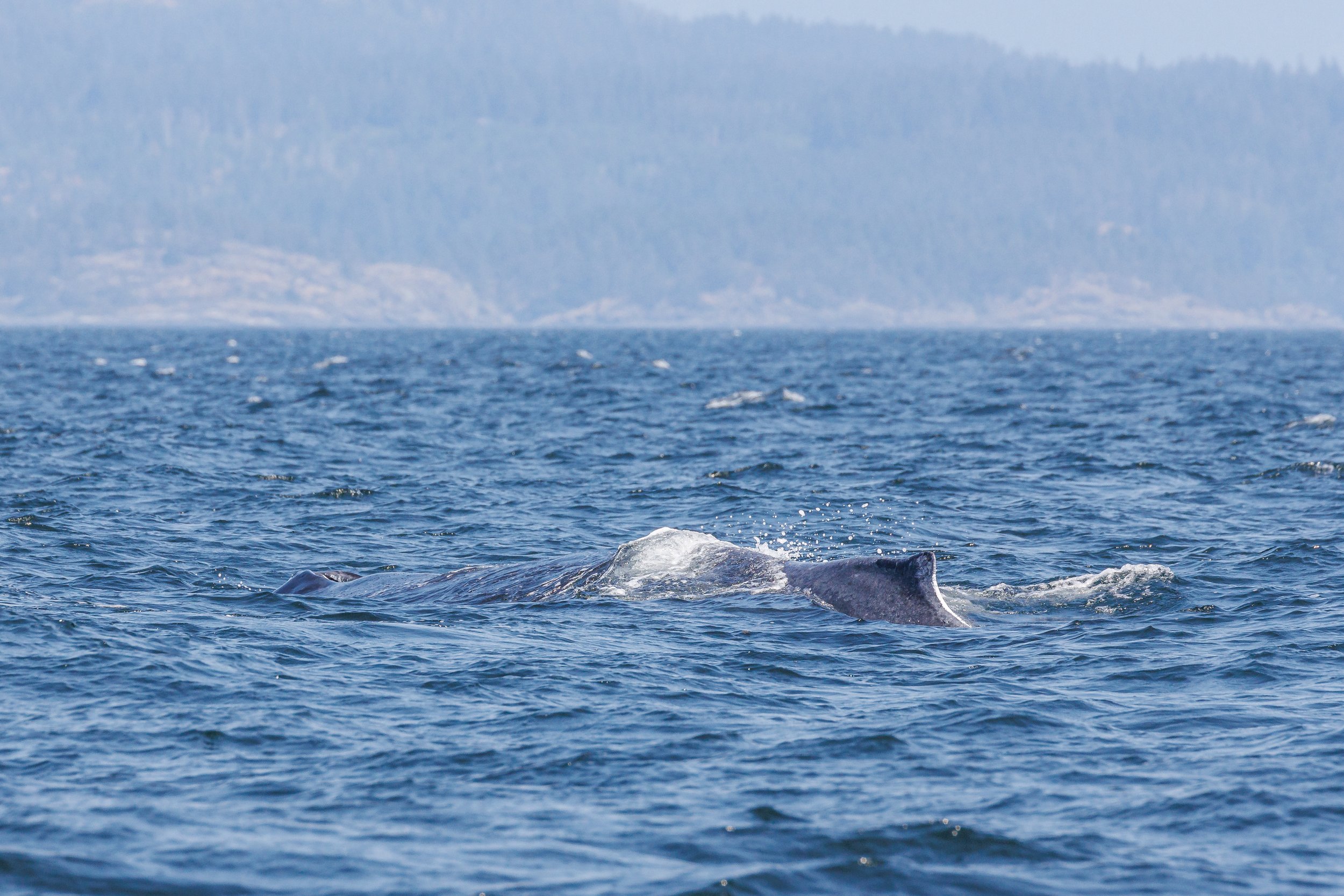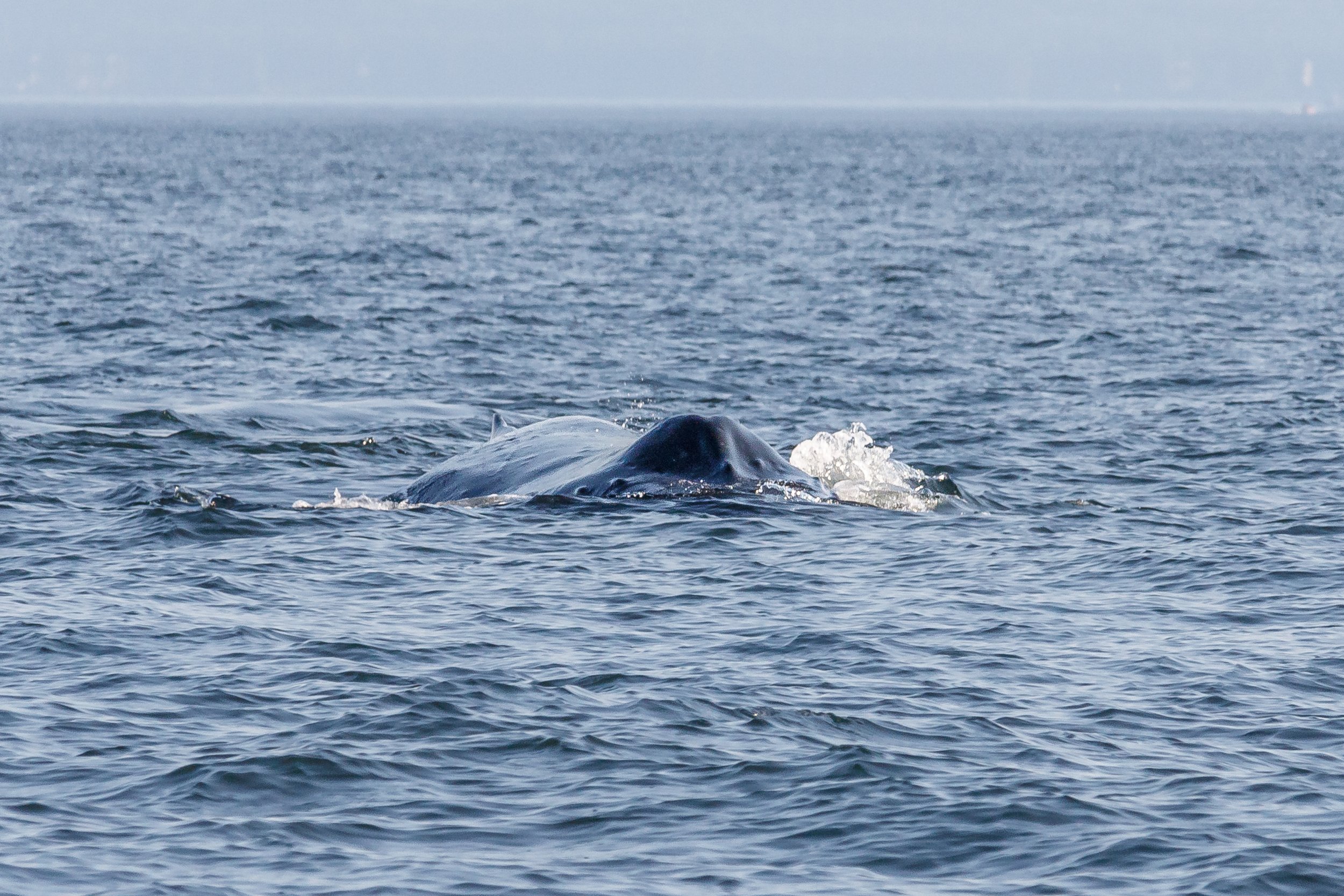July 5, 2023 - Humpback soup in the Strait of Georgia
We are starting to get fully into the swing of humpback Season! Spotting these gentle giants is becoming more and more common as time goes on and we’ve noticed a pattern. These early-season sightings have consisted of a high amount of young whales! Today was no different as we saw a total of 4 humpback whales: Europa (BCX0845) and calf, Mammoth’s 2022 calf (BCX1710 calf 2022), and Callisto (Europa’s 2021 calf)! It was very interesting that Europa’s previous calf was spotted in the same general area as their mom and her new calf! Although in this case, it might just be a coincidence. While it is likely they knew of each other’s presence in the same general area today, there was no indication that they were actually communicating with each other while we were on scene. Mammoth’s 2022 calf and Callisto were actually travelling in the exact opposite direction of Europa and her current calf.
Today Europa and her 2023 calf were circling around the Halibut Bank ODAS buoy. Halibut Bank is one of the many places our Humpbacks tend to congregate around during our summer months. Shoals of certain fish (such as sand lance) tend to live in or near sandy banks, making these areas essentially giant humpback buffets!
It is very important that Europa eats well as she needs all the food she can get right now so she can produce milk for her calf. Humpbacks, just like humans, are mammals - and humpback calves usually nurse for around seven months before they are weaned and switch to a more solid food diet. At this time of the year, it is likely the calf has started having little swallows of whole food, but still will rely on Europa for her milk for a couple more weeks.
After leaving our whales, we had a couple more wildlife stops before we headed back to port. Our seals were sleepily hanging out in the intertidal zone. The intertidal zone is the area of land that is exposed during low tides but covered during high tides. This area is usually highly biodiverse and tends to be covered in seaweed. This seaweed creates a lovely soft ‘bed’ for our seals to lounge on.
The Gabriola Bluffs were as busy as ever as our cormorants darted around, fishing for themselves and their chicks. We often stop here to visit the birds and to also have an up-close-and-personal view of the sandstone erosion found along the base of the bluffs.
We also made a quick stop at one of our resident Eagle nests. The pair of Eaglets in this nest, lovingly known as Freddy and Pinecone, are beginning to fledge. Fledging means they are beginning to be able to fly. Interestingly, birds aren’t able to fly right after they come out of their shells. This timetable by GROWLS (Gabriola Rescue of Wildlife Society) is a great resource to use when you are wondering how much longer your local Eagles will be around. It seems our daring duo is right on schedule, as GROWLS notes many of our local Eagles begin flapping their wings and jumping around the nest around July 10th.
While we are sad that our local Eagles will soon be leaving their nests, we are excited to watch them grow and hopefully return back to our area later this year.
Today’s photos were taken by Marine Naturalists Vanessa Vereschahen, Des Poier, and Cheyenne Brewster.
Callisto preparing to dive. Photo by Des Poier.
Mammoth’s 2022 calf (BCX1710 calf 2022) Photo by Des Poier.
One is coming up, ones is going down! Photo by Des Poier.
Mammoth’s 2022 calf (BCX1710 calf 2022) Photo by Des Poier.
Mammoth’s 2022 calf showing off its tail! Photo by Vanessa Vereschahen.
Callisto’s dorsal fin. Photo by Des Poier.
The underside of Callisto’s fluke. Photo by Des Poier.
A look right up the blowholes! Photo by Des Poier.
Europa (BCX0854) Photo by Des Poier.
Europa surfacing. Photo by Des Poier.
Europa (BCX0854) Photo by Des Poier.
Europa (BCX0854) Photo by Des Poier.
Europa (BCX0854) going for a dive! Photo by Des Poier.
Europa (BCX0854) Photo by Des Poier.
Europa (BCX0854) Photo by Des Poier.
Europa (BCX0854) Photo by Des Poier.
Europa lifting her tail for a dive. Photo by Des Poier.
Europa surfacing. Photo by Des Poier.
Going for a dive! Photo by Des Poier.
Europa lifting her tail for a dive. Photo by Des Poier.
Europa is named for the barnacle scars that look like craters on the underside of her tail flukes. Photo by Des Poier.
Europa’s Dorsal fin. Photo by Des Poier.
Europa going for a dive! Photo by Des Poier.
Europa and her 2023 calf! Photo by Vanessa Vereschahen.
Europa preparing to dive! Photo by Vanessa Vereschahen.
Europa lifting her tail for a dive. Photo by Vanessa Vereschahen.
Europa sticking her face out of the water before a dive! See the tubercules? Photo by Vanessa Vereschahen.
We call this a fluke waterfall! Photo by Vanessa Vereschahen.
Europa diving beneath the water. Photo by Vanessa Vereschahen.
Cute little Harbour Seals hauled out in the intertidal. Photo by Cheyenne Brewster.
Getting hit by a wave! Oh no! Photo by Des Poier.
Seal overboard! Photo by Des Poier.
A couple of Black Oyster catchers on Snake Island. Photo by Des Poier.
One of our watchful eagle parents. Photo by Des Poier.
Keeping an eye on the nest. Photo by Des Poier.
Pinecone and Freddy practicing with their wings. Photo by Des Poier.
Pinecone didn’t appreciate the audience. Photo by Des Poier.
Cormorants along the Gabriola Bluffs. Photo by Vanessa Vereschahen.
Our boats watching the whales! Photo by Cheyenne Brewster.







































